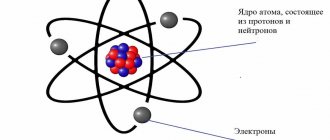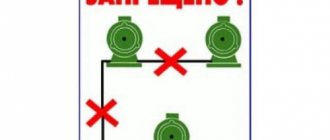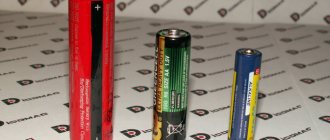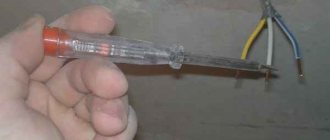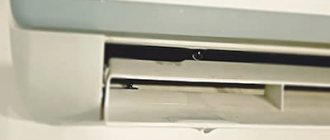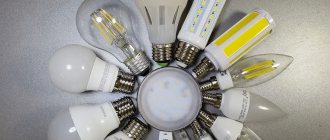Where in the PUE does it say that reinforcement can be used as vertical grounding conductors?
PUE, clause 1.7.109. The following can be used as natural grounding conductors: 1) metal and reinforced concrete structures of buildings and structures in contact with the ground, including reinforced concrete foundations of buildings and structures that have protective waterproofing coatings in non-aggressive, slightly aggressive and moderately aggressive environments
;
2) metal water pipes laid in the ground; 3) casing pipes of boreholes; 4) metal sheet piles of hydraulic structures, water conduits, embedded parts of valves, etc.; 5) rail tracks of main non-electrified railways and access roads if there is a deliberate arrangement of jumpers between the rails; 6) other metal structures and structures located in the ground
; 7) metal shells of armored cables laid in the ground. Cable sheaths can serve as the only grounding conductors when there are at least two cables. Aluminum cable sheaths are not allowed to be used as grounding conductors.
GOST R 50571.5.54-2013/IEC 60364-5-54:2011 Low-voltage electrical installations. Part 5-54. Grounding devices, protective conductors and protective potential equalization conductors
INSTEAD GOST R 50571.5.54-2011/IEC 60364-5-54:2002 542.1.4 The following requirements are imposed on grounding devices intended for use in the ground: - they must reliably ensure the protection requirements of the installation; — the flow of ground fault currents and protective conductor currents to ground should not create a danger from heating, thermomechanical and electromechanical effects and the danger of electric shock; — if necessary, they must satisfy functional requirements; — be suitable for external influences (see IEC 60364-5-51), for example mechanical stress and corrosion. 542.2 Grounding Electrodes (Ground Electrodes) 542.2.1 The types, materials and sizes of grounding electrodes shall provide corrosion resistance and the required mechanical strength for the entire service life. NOTE 1 From a corrosion perspective, the following factors may be considered: soil pH, soil resistivity, soil moisture, AC and DC stray and leakage currents, chemical contamination and proximity of incompatible materials. The minimum dimensions of grounding electrodes made of the most common materials in terms of corrosion and mechanical resistance, laid in the ground and embedded in concrete are given in Table 54.1. Note 2—The minimum thickness of the protective coating should be greater for vertical ground electrodes than for horizontal ground electrodes due to the greater mechanical stress when they are buried. Table 54.1 - Minimum dimensions of grounding electrodes laid in the ground from the most common materials in terms of corrosion and mechanical resistance
542.2.3 The following can be used as grounding electrodes: - foundation grounding electrodes embedded in concrete; Note - For further information see Annex C; — foundation grounding electrodes buried in the ground; — metal electrodes buried directly into the ground vertically or horizontally (for example, rods, wire, tape, pipes or strips); — metal sheaths or other metal coverings of cables in accordance with local conditions or requirements; - other buried metal products in accordance with local conditions or requirements. - metal reinforcement of reinforced concrete (with the exception of stressed reinforced concrete) located in the ground.
I will continue this topic a little. After reading various sites and returning here, it became clear to me that the proposals widespread on the Internet for burying triangles with vertical pins on ferrous metal welding do not meet the requirements for ensuring normal grounding due to corrosion. However, there are a number of companies offering “do-it-yourself kits” - a rod system, the total depth of which is increased by screwing new rods onto those already driven into the ground. The rods are made from various materials, for example, stainless steel or copper-plated metal, etc., and have a diameter of 14-16 mm. They write that the system is guaranteed to work for up to 100 years. I just have a question: have you come across this product? I don’t really believe that one such rod, even driven six meters deep, will provide good grounding. Moreover, I did not find information on these sites at what distance from the building it is generally proposed to hammer this work. Please share your thoughts and experiences.
You are talking about a modular-pin grounding system. Electrodes are manufactured in accordance with the requirements of GOST, which is given in the previous message.
This type of grounding is installed quickly and does not require large labor costs for excavation work. Service life of at least 30 years. They lied to you about a hundred years.
Grounding loop - its design and choice of ground electrode
—>The device of the so-called buried grounding loop externally consists of electrodes - metal rods that are driven into the ground and connected to each other. The most effective design is considered to be one in which the electrodes are arranged in one line. However, under favorable conditions, a design in which the rods are arranged in a triangle will also work quite well.
Grounding device if the pins are located in one line
Grounding device in case of pin arrangement in the form of a triangle
Other options
There are other natural grounding agents.
To explore suitable options, you can use the PUE clause 109 of section 1.7. It states that using a steel pipeline is quite suitable. The main condition is the presence of non-flammable liquid inside the pipeline. In addition, a metal well casing can be used as a natural grounding conductor. For power lines, reinforced concrete footrests are used as grounding conductors, since they are well moistened upon contact with the ground.
Thus, using natural grounding conductors can significantly save time and money, but it is necessary to take into account a large number of factors that can affect safety. The structures must not only form a single circuit, but also provide resistance not exceeding the permissible parameter.
Step-by-step instructions for installing grounding yourself
- The underground part of the ground electrode must be located at a distance of more than one meter from the foundation of capital buildings.
- The vertical ground electrode must be dug into the soil to a depth below the level of soil freezing or the level of soil drying (for southern latitudes), that is, to a depth where a constant level of humidity is maintained.
- To bury the ground electrode, it is necessary to dig a trench (triangular) and convenient holes (0.5 - 0.7 m) at the locations of the vertices of the triangle for its installation and scalding.
- Now we drive metal corners into the ground along the vertices of the dug triangle. This work will be greatly simplified if the lower part of the corner is first sharpened. Above the surface we leave the edge of the corner 25 - 30 cm long.
- After all (3 pieces) of the corners have been driven in, they are connected to each other, forming a triangle, or the finished triangle is welded at its vertices to the hammered corners.
- All welded areas should be treated with a primer to create an anti-corrosion layer.
- A trench is dug from the triangle to the point where the tire is inserted into the house. A horizontal grounding conductor is installed in it.
- In front of the electrical panel, an M5 or M8 bolt is welded to the end of the bus (round wire or strip) for convenient fastening of the ground wire and connecting it to the panel.
- All trenches are covered with earth.
Further connection of the ground loop to the electrical wiring of the house must be carried out according to a clearly developed diagram and a specific connection system.
Checking the grounding functionality
After completing all work, it is necessary to check the functionality of the protective circuit. Ideally, this should be done with a calibrated instrument designed to measure grounding resistance, but at home you can use a multimeter - a multifunctional device designed to measure basic electrophysical quantities.
To make sure that the circuit is working properly, it is necessary to measure the voltage between the phase wire in the panel and the ground bus when the voltage is on.
In this case, the multimeter must be turned on in voltmeter mode with a limit of 250-500 V. If, during the measurement, a value of about 220V appears on the device’s display, then everything is working properly. Otherwise, if there is no voltage, there is a line break and it is necessary to check where the error was made and where the contact was lost.
It is best to entrust the above work to qualified electrical personnel. The serviceability of grounding must be checked annually. This is done by tapping the weld seams above the ground with a hammer. If the connection is broken somewhere, tapping will reveal this place.
Electrophysical tests are also carried out. The work is performed by qualified electrical personnel. Remember, a faulty grounding system puts your family members at unnecessary risk.
Do pipelines need to be grounded? and how can this be done?
According to GOST R 505 71 (M EK 364), grounding and grounding of pipelines must be carried out for all metal circuits associated with electrical installations > ≈ 42 V or > - 11V. For alternating and direct currents less than the specified values, grounding is not necessary. In fact, what we constantly encounter in life is somewhat larger than these numbers, therefore, it never hurts to know the instructions for installing grounding.
Fittings: main types and applications
Typically, the fitting should be the same material as the pipe you are installing it to. For example, use a PVC fitting with a PVC pipe. (There are exceptions where materials that meet certain codes and standards may be used in pipes of other materials.) Material options include:
Copper
- Used in hot and cold water supply systems.
- Commonly used in residential water lines and as a refrigerant line in HVAC systems.
- Available in soft form (usually for refrigerant lines) and hard form for water lines.
- Copper pipes are usually joined using flared joints, compression joints, and soldered or soldered joints.
PVC (polyvinyl chloride)
- The most common type of plastic, it is rigid and can have a variety of pressure ratings.
- Only for cold water. Typical uses include cold water supply and sewerage.
- PVC fittings are connected by threads or welded joints (glue).
CPVC ( chlorinated polyvinyl chloride)
- Similar to PVC, but suitable for higher temperatures and more flexible.
- Mainly used for hot and cold water supply to residential premises.
- Often replaces copper pipe indoors.
- CPVC fittings are connected by threading or welding (glue).
PEX
- For domestic hot and cold water supply, as well as for water heating.
- Competitively priced and easy to use.
- PEX connects to plastic handle or metal crimp and clamp fittings.
Good to know!
Make sure you choose a material that is appropriate for the type of plumbing job you are doing. For example, some pipes are approved for compressed air or gas, others are approved for potable or non-potable water. Always check local regulations to ensure that the materials you select meet current standards.
Ground loop materials
The grounding loop must have high mechanical strength, low electrical resistance and the ability to be connected reliably. In addition, an important role when choosing a material is played by its cost.
Pin parameters and materials
Electrodes or pins are usually made of steel profile. This material is attractive due to the possibility of deepening the rods by simply driving it in. At the same time, its electrical resistance fully satisfies the requirements with a sufficient cross section. Pins can be made from the following materials:
- Bar. The most common option is a rod with a diameter of 16-18 mm. It is not recommended to use fittings, because it is heated, which leads to an increase in resistivity. In addition, the corrugated surface leads to irrational use of the rod cross-section.
- Corner. The most commonly used corner is 50x50 mm in size with a wall thickness of 4-5 mm. The bottom is pointed to make driving easier.
- Pipe with a diameter of more than 50 mm with a wall thickness of 4-5 mm. Thick-walled pipes are recommended for hard soils and regions with frequent droughts. Holes are drilled at the bottom of such a pin. When the soil dries out, salt water is poured into the pipe, which increases the dispersive ability of the soil.
Why is reinforcement not suitable as a grounding conductor?
One of the widespread methods of grounding a private house is modular-pin, using conventional reinforcing rods. But also according to GOST R 50571.5.54-2013/IEC 60364-5-54:2011 Low-voltage electrical installations, introduced on January 1, 2015, and according to GOST 58882-2020, which entered into force on January 1, 2022, “Grounding devices. Potential equalization systems. Grounding electrodes. Grounding conductors", steel is not suitable for these purposes. For electrical installations with voltages up to 1 kV, the grounding system can only be made from corrosion-resistant materials:
- stainless steel;
- galvanized steel (hot-dip galvanizing or electrolytic coating, with a minimum zinc layer thickness of 1 micron);
- copper plated steel (minimum 70 microns radial copper coating with 99.9% copper content);
- copper.
Considering our attitude to various standards, even from professionals, not to mention self-builders, when choosing a material for grounding conductors, it is worth starting from expediency. Yes, fittings are available and even now, when they have risen in price several times, the costs will be minimal. However, grounding is not arranged for a year, not for five, and not even for ten or twenty - ideally, forever. In the foundation, the reinforcement cage is protected by a layer of concrete, which prevents direct contact with moisture; in the ground, the steel is not protected by anything and is unlikely to last even a decade. Whereas a specialized kit will last much longer.
Gennady ChebatarevTechnical specialist at OBO Bettermann
According to GOST R 50571.5.54-2013/IEC 60364-5-54:2011, part 5-54 “Grounding devices, protective conductors and protective potential equalization conductors”, ferrous metal cannot be used for grounding. And most importantly, ferrous metal will rot in the ground in 2-5 years. The service life of the OBO Bettermann grounding kit is up to 50 years! Installation of a special grounding conductor guarantees good grounding characteristics.
In the private sector
Grounding loops in the private sector can be made in different ways and this is a topic for a separate article, but here we will look at the basic principles of such a device. In most cases, a triangle is made, where a steel corner 50X50 mm or reinforcement Ø 10-14 mm is used as pins. They are welded together either with wire rod or a 20X5 mm steel strip at a distance of a meter. The approximate depth is from 2 to 3 meters, but this depends on the soil. The strip is carefully welded to the pins - the seam must only be of high quality.
Now, the most important thing: take the tester in your hands and measure the resistance between the two pins - it should not be more than 4 Ω, but the strip or wire from the house to the circuit should not be more than 0.1 Ω. In this case, you will never get an electric shock in the toilet, bathroom or kitchen when you use the water supply or sewer system.
What is a natural grounding agent?
For safe operation of various electrical installations, grounding is required. Natural grounding is one of the common measures. It can be used as steel reinforcement, which is part of the concrete structure. In addition, other metal devices located in the ground are applicable. Plumbing communications and cables are suitable; less commonly, above-ground structures, such as metal pipes or rails, can be used for the ground electrode.
How to make a ground loop correctly: design elements
For a private house, the grounding structure traditionally looks like this: several vertical grounding conductors dug into the ground, which are connected to each other by horizontal grounding conductors or contact conductors, and they, in turn, connect the entire grounding loop to the electrical panel and, accordingly, to the devices.
The residual current device is designed to protect against electric shock to a person. How it works and how to choose an RCD for your house or apartment can be found in the article “The principle of operation of an RCD.”
If you are used to doing everything yourself, then you can find out how to make a sewer system in your dacha yourself from this article.
And this material provides a detailed analysis of water supply pipes. After all, if we talk about a country house, then this is quite a serious investment, and everything must be done reliably and “to last forever.”
- The vertical ground electrode is a prefabricated (welded) structure: a conventional metal corner 2 to 3 m long (50 × 50 x 5 mm) and a welded equilateral triangle made of steel strip (40 × 4 mm) with a long side of 1.2 m.
- A horizontal grounding conductor (metal connection) is a steel strip (40 × 4 mm) or round steel (8 - 10 mm2), which is connected to the upper ends of the vertical grounding conductors and inserted into the house in the form of a grounding bus. There may be several input grounding bars into a house, but one must go to the switchboard (VShch, ASU).
The final grounding is a single rigid structure with underground and above-ground parts.
Selecting a system and drawing up a diagram
There are three grounding systems in total: TT , IT , TN , of which the latter is divided into three more varieties - TN-S , TN-C , TN-CS .
In private housing construction, TN-CS or TT system designs are usually used, and TN-CS looks more attractive since there are fewer requirements for its installation.
The system starts from the main grounding bus, which is installed either in the electrical panel of the house or in the input device cabinet.
The most rational solution is when the grounding is located on a support that redirects the electric main into the house.
The TT system is used much less frequently. This is handled by representatives of the energy supply organization, and if the owner still decides to save money and carry out the installation himself, then the same Energosnab employees will come to certify the documents.
If you still take a chance and choose a CT grounding scheme for a private house, then do not forget about the mandatory installation of an RCD!
New on the forum
Latest Articles
Garden hand tools: types and features of choosing equipment
Any garden, regardless of size, needs care. To ensure it at the proper level, you need to purchase a whole set of different tools. They will help with planting and uprooting plants, cutting branches and other operations. There is a wide variety of gardening equipment. The most popular types include tools such as: pitchforks and shovels; scissors; combined systems; pruners; […]
How does the suction pump work?
Sludge suckers have proven their usefulness in cleaning wells, cesspools, and septic tanks. They are also in demand for cleaning sedimentation tanks and sewerage systems. The sludge pump performs the same functions as the sewage disposal equipment, but has advantageous differences: - Its tank is designed so that liquid components are filtered from solid ones. For this reason, the device is used for both collecting and cleaning [...]
Grounding in a private house made of smooth reinforcement and steel strip
Smooth steel reinforcement, angle and strip are quite suitable materials for the manufacture of the main ground loop.
Practice shows that for the manufacture of a grounding loop in a private house, a linear grounding scheme and a triangular grounding scheme using three vertical grounding electrodes are quite suitable.
A linear grounding scheme is usually used when there is not enough space (territory) to place a triangular grounding loop near a private house, but no further than 10 meters from the object.
The electrical characteristics of both circuits are almost identical, and depend to a large extent on the properties of the soil of your land.
Horizontal and vertical grounding conductors must be made of black or galvanized steel or copper. Due to their high cost, copper grounding conductors are, as a rule, not used. Also, grounding conductors should not be made from corrugated reinforcement - the outer layer of the reinforcement is hardened, which disrupts the distribution of current across its cross-section, and it is more susceptible to corrosion.
It is recommended to use smooth, unpainted reinforcement with a cross-section of at least 1.5 sq cm, that is, A1 (smooth) reinforcement with a diameter of 16 mm is quite suitable for grounding the electrical installation system of a private household.
Take the length of the grounding electrodes 3 meters, the distance between them is 2.5 - 3 meters, you can’t go wrong.
From this reinforcement it will be possible to make vertical electrodes with connections to the house, to the exit to the house (attached to the foundation). Weld a bolt D 8-10 mm to the end of the reinforcement, and insert a copper cable crimped with copper lugs into the house to the switchboard.
The resistance of the manufactured ground loop for a private home should be 10 ohms and below.
Step-by-step instructions for installing grounding yourself
- The underground part of the ground electrode must be located at a distance of more than one meter from the foundation of capital buildings.
- The vertical ground electrode must be dug into the soil to a depth below the level of soil freezing or the level of soil drying (for southern latitudes), that is, to a depth where a constant level of humidity is maintained.
- To bury the ground electrode, it is necessary to dig a trench (triangular) and convenient holes (0.5 - 0.7 m) at the locations of the vertices of the triangle for its installation and scalding.
- Now we drive metal reinforcement bars or steel angles into the ground along the vertices of the dug triangle. This work will be greatly simplified if the lower part of the corner or fitting is pre-sharpened. Above the surface we leave the edges 25 - 30 cm long.
- After all 3 electrodes are driven in, they are connected to each other, forming a triangle, or the finished triangle is welded at the tops to the driven corners.
- All welded areas should be treated with a primer to create an anti-corrosion layer.
- A trench is dug from the triangle to the point where the tire is inserted into the house. A horizontal grounding conductor is installed in it.
- In front of the electrical panel, an M5 or M8 bolt is welded to the end of the bus (round wire or strip) for convenient fastening of the ground wire and connecting it to the panel.
- All trenches are covered with earth.
Further connection of the ground loop to the electrical wiring of the house must be carried out according to a clearly developed diagram and a specific connection system.
Grounding a private home performs two important functions:
- protecting people from electric shock;
- protection of new generation household appliances (with microprocessor control) from emergency conditions in the electrical network.
The occurrence of emergency modes, in part, can be provoked by the presence in everyday life of modern powerful equipment that increases the load on electrical networks, the quality of which does not meet modern operating conditions.
The grounding function is especially important in dacha settlements and villages, where power supply problems are most pronounced. The real risk of using powerful household appliances is present in rooms with high humidity. Heating electrical appliances can only be used if there is a complete grounding loop.
Classification of fittings
Smooth reinforcement is a round steel rod with a flat surface and a certain strength class: A1 or A240. Unlike smooth reinforcement, corrugated reinforcement has a wavy surface with periodically repeating corrugations, as well as varying strength (A2, A3, A4, A5, A6). Class A1 reinforcement is used to create a single frame, which is why smooth reinforcement is called assembly reinforcement. Corrugated reinforcement is used in places where there will be tension and heavy loads, for example, when laying a foundation. The cross-sectional diameter of corrugated reinforcement is larger than the diameter of smooth reinforcement. In general, the main characteristics of any reinforcement are strength, reliability, and corrosion resistance.
It is impossible to build any structure without reinforcement, because it plays the same role as the skeleton in the human body. To date, no analogue to steel reinforcement has been invented, because its strength, durability and relatively low price allow it to remain a leading position in construction. The reinforcement bars can be tied together and welded without loss of strength at the connection point, which adds reliability. The foundation of any structure, be it a small house, a multi-story structure or a skyscraper, cannot be made without reinforcement, because it is this that ensures integrity and reliable connection.
Grounding a private house using fittings.
An equally important property is its high electrical conductivity. This quality can be used when making grounding in a village or country house. After all, everyone knows that when using household electrical appliances and using electricity in general, it is necessary to ground them so as not to receive an electric shock or allow sparks or fires.
You can make grounding yourself. The simplest option for equipping a grounding circuit is a triangle with steel electrodes at the tops, dug into the soil to a depth of 1.5 to 3 m, i.e. below the ground freezing level. The electrodes are connected to each other using a welding machine with fittings. The electrodes can be round reinforcement with a diameter of 10-16 mm, a steel corner 50x50x5 and a strip 40x4. By making even such a simple structure, you will protect yourself and your family from troubles associated with electricity.
Using reinforcement in a summer cottage
So, the country house is built, electricity can be used without fear, and all this is not without the use of steel reinforcement. But the scope of application of this type of rolled metal is not limited to this. An excellent solution for making a greenhouse or greenhouse would be the same steel reinforcement. A metal product will last for many years and will be reliable and durable. You can make a collapsible or welded greenhouse, cover the frame with plastic film or cellular polycarbonate. A greenhouse made from the above materials is good and durable. Quite often, after building a house, various materials remain: boards, fittings, timber, etc.
An excellent solution for tying up seedlings in a garden plot would be pieces of reinforcement. This is the most reliable material, because it will not collapse under the influence of moisture and will not deform. In general, steel reinforcement, smooth and corrugated, is a fairly versatile product that can be used in any area.
Features of connecting the main switch in the TN-C and TN-C-S circuits
In circuits assembled according to these standards, the grounding wire is absent or is combined in certain sections of the wiring with a zero N-neutral; it is allowed to use a PEN bus as a ground wire. In the distribution board, all wires from the ground loop, power lines and ground from various building wiring groups are connected to this bus. In this case, the grounding bus is connected by a separate wire to the bus for lines with an insulated neutral N.
Thus, it is possible to use the steel cabinet body as the main ground bus
Connecting the main switch to the ASU located on power line poles
The peculiarity of this connection option is that the ASU cabinets are on poles, have their own grounding system and are very often connected to the house via a cable suspended by a cable.
In these cases, a wire from the grounding pole, a grounding line of a power transmission line, and a branch from a metal cable are connected to the GZSh. In addition, the main buses of the ASU of the pole and the ASU of the house are connected by a separate line. The cable is grounded on both sides, to the bus near the power line and to the bus in the ASU for the home.
Aggressive soils and protection of reinforced concrete from their effects
Currently, issues of protecting reinforced concrete structures from the aggressive influence of soils are regulated in Russia by the interstate standard GOST 31384-2008 “Protection of concrete and reinforced concrete structures from corrosion. General requirements". According to this GOST, the aggressiveness of the soil is determined by the depth to which concrete collapses or loses its protective properties relative to steel reinforcement over 50 years. Weak degree of aggressiveness - less than 10 cm, medium - from 10 cm to 20 cm, high - more than 20 cm.
Primary methods of protection include changes in the composition of concrete, as well as a set of design and engineering solutions that reduce the level of corrosion. The concrete must be denser, providing better protection for the steel reinforcement than usual. Secondary measures include applying protective coatings to reinforced concrete structures, as well as treating them with an antiseptic if the cause of corrosion is the action of bacteria.


